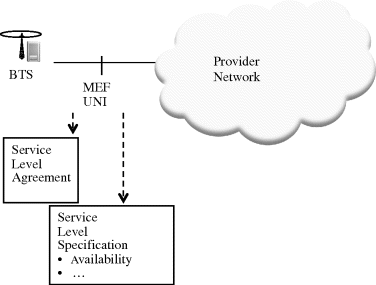7.3.1 Carrier Ethernet
Reliability is one of the attributes of the term Carrier Ethernet as defined by MEF [12]. How is reliability of Carrier Ethernet for the mobile backhaul then achieved?
The MEF service is delivered by a service provider. The provider network is carrier grade, and built with his technology of choice for resilience. The user sees the service through UNI characteristics. See Figure 7.9.
Figure 7.9 Provider network and customer network.

Provider's network is isolated from the customer networks and the resilience deployed by the provider is not visible to the customer. Similarly, the resilience within the customer site is separate from that of the provider network.
Standardization bodies have addressed the topic of carrier grade Ethernet with solutions that differ from the native Ethernet concepts. From the service user viewpoint, availability is simply one characteristic of the service. How it is implemented is a subject for the service provider.
Availability of Metro Ethernet services may be supported by multiple technologies in the provider network. In the case of Sonet/SDH, protection switching at the Sonet/SDH layer can be used. As with TDM in general, a drawback is the static and rigid capacity allocation. Virtual concatenation feature of NG-SDH makes the network more flexible, however the root of the issue remains.
Often Ethernet link aggregation helps achieving carrier grade resilience. Since the MAC layer does not see individual links of the aggregated connection, it is possible to support redundant ports, without involving the MAC layer.
ITU-T has defined two protection switching standards for the Ethernet: G.8031 and G.8032. These are intended for providing resilience in Ethernet networks.
IETF L2 VPN working group has produced a set of specifications that define an implementation of the L2 service with an IP/MPLS network. VPLS defines a multipoint service (E-LAN) while VPWS defines a point-to-point (E-Line) Ethernet service. Recovery is based on IP and MPLS.
7.3.2 MEF Services
For the user of MEF services, availability and QoS are characteristics of the service, and as such, they are more important than information of how protection or restoration is actually implemented. QoS and availability of an offered service can be defined in a service level specification, which is part of a service level agreement. The attributes of the service at the UNI are relevant.
For the service provider implementation of resilience is a key issue. As MEF compliant Ethernet services may be delivered over different technologies, resilience is tied to the technology used in the provider network. It also depends on the type of service, E-Line, E-LAN, or E-Tree. Example technologies are Ethernet over Sonet/SDH, Ethernet over MPLS, Ethernet over DSL and a point-to-point Ethernet. For the Ethernet layer, link aggregation and RSTP are mentioned in MEF [13].
As MEF looks at the situation mainly from a service viewpoint, availability is an attribute that can be negotiated with the customer and the service provider. This attribute is in the scope of a Service Level Specification (SLS) [14] as shown in Figure 7.10.
Figure 7.10 Availability attribute in a MEF SLS.

The value of the attribute is then subject for negotiation. It is defined in MEF as specific to the Class of Service (CoS) label. This allows separate availability for each CoS type.
Having the availability attribute defined in the SLS is the main tool for the user of the service. Primarily, if the BTS or other customer equipment needs a higher availability for the MEF service, it is a subject of negotiation with the provider.
7.3.3 Ethernet OAM
Ethernet OAM (Operations, Administrations and Maintenance) provides for failure detection rather than for recovery itself. With MEF services, it is a tool that can be used to detect failures and monitor connectivity. Ethernet OAM can be used as a trigger for protecting switching. In IEEE, Spanning Tree Protocol is intended for the recovery.
Ethernet OAM was introduced in Chapter 04. Figure 7.11 shows an example application. An Ethernet service (e.g. E-Line) provided by a service provider is used between a BTS and an IP router.
Figure 7.11 Link OAM between BTS and PE.

Ethernet link OAM [15] monitors the first mile from the BTS to the PE device. Link OAM is capable for single-hop application only, so the Link OAM is terminated at the PE device.
An example of using CFM [16] in the same case, is shown in Figure 7.12. The mobile operator configures a MEP (Maintenance End Point) to the BTS and to the peer entity, and can now use connectivity monitoring. The mobile operator sees the PE as a MIP (Maintenance Intermediate Point). Provider network however is not accessible to the customer.
Figure 7.12 CFM for a mobile backhaul Ethernet service.

For connectivity monitoring, connectivity check messages (CCMs) are sent regularly. For fast failure detection, the message interval can be as short as 3.3ms. Values are configurable. A failure is detected, if three CCM messages are lost. An alarm is raised as a consequence, additionally, Ethernet automatic protection switching application may use Ethernet OAM as a trigger. The minimum value mentioned (3.3 ms message interval) is aggressive. If the links are not constantly up but may be flapping, a false trigger is easily caused.
While CCM is operated constantly as a keep-a-live at Ethernet level, Ethernet loopback is comparable to ping: a MEP or MIP is asked to reply. Ethernet link trace corresponds to a trace route application. CFM protocols relate to a service (VLAN) and to a maintenance domain.
In cases where the failure cannot be recovered immediately e.g. by protection switching Ethernet level ping and traceroute help in troubleshooting. This shortens the time needed to find the faulty link or bridge, and consequently increases availability.
Ethernet Connectivity and fault management (CFM) supports nested maintenance domains. Maintenance domains allow customer and provider domains to be kept separate. A service provider may use connectivity and fault management within his maintenance domain, to monitor the Ethernet layer connectivity within his network – provided that the service is implemented using Ethernet technology. If the service is implemented using MPLS (or NG-SDH), service provider uses Sonet/SDH or MPLS layer OAM mechanisms instead of the Ethernet OAM.
